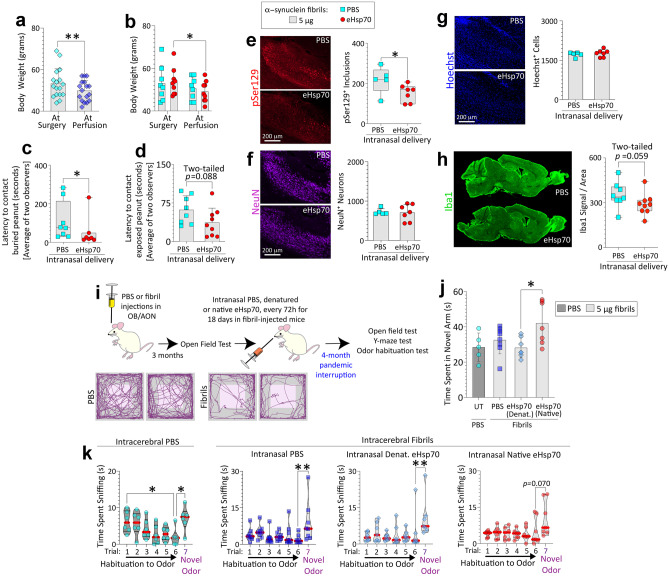Fig. 7.
Daily intranasal eHsp70 delivery for 28 days reduces inclusion numbers and the time taken to contact buried food in preformed α-synuclein fibril-injected aged male mice. Aged, 20-month-old male mice were injected with 5 µg α-synuclein fibrils in the olfactory bulb/anterior olfactory nucleus complex (OB/AON; a–h). After 24 h and then daily for 28 days, mice were infused with 2 µg of Ssa1 (yeast homologue of Hsp70, ~ 74% homology with HSPA1A) or an equivalent volume of sterile PBS (2 µL). See SI methods for sample sizes and exclusion criteria. Body weights are shown in a–b. The buried (c) and exposed pellet (d) behavior tests were performed before sacrifice and analyzed by two blinded observers (shown are the averages). Blinded measurements of pSer129+ inclusion counts (e), NeuN+ neuronal numbers (f), and numbers of Hoechst+ cells (g) in the AON are shown. Representative photomontages of pSer129+ inclusions, NeuN+ neurons, and Hoechst-stained nuclei from the PBS or eHsp70-infused mouse AON are shown in e–g. Levels of Iba1 (marker for microglial activation) signal in the OB/AON were normalized by the area of the traced region in h. * p ≤ 0.05, ** p ≤ 0.01; data in panel a were analyzed by the two-tailed paired Student’s t-test. Data in panel b were analyzed by the repeated measures two-way ANOVA followed by Bonferroni post hoc. Data in panels c, e, h were analyzed by the two-tailed Mann–Whitney U. Data in panels d, f, g were analyzed by the two-tailed unpaired Student’s t-test. i–k Five-month-old male mice were injected in the OB/AON with 5 µg of α-synuclein fibrils (n = 31) or an equivalent volume of PBS (1 µL; n = 7). See SI methods for sample sizes and exclusion criteria. Three months after fibril injections, mice were tested on an open-field apparatus to confirm behavior deficits (AnyMaze trackplots in i) before initiating intranasal infusions of PBS (6 µL), denatured eHsp70 (6 µg in 6 µL), or native eHsp70 (6 µg in 6 µL) to test the neurorescue potential of eHsp70 in fibril-injected mice (timeline in i). Due to the pandemic lockdown, we were only able to perform the intranasal infusions for 18 days, and the animals were tested on a battery of behavior tests upon our return to the lab 4 months later. Mice were tested on a Y-maze apparatus in j (UT = untreated). Time spent by the mice in the novel arm of the Y-maze apparatus was analyzed on AnyMaze (j). Data for all seven trials of the odor habituation/dishabituation test are shown in k. * p ≤ 0.05, ** p ≤ 0.01. Data in panel j were analyzed by one-way ANOVA followed by Bonferroni post hoc. Data in panel k (non-normally distributed by Shapiro–Wilk test) were analyzed by the Kruskal–Wallis test

